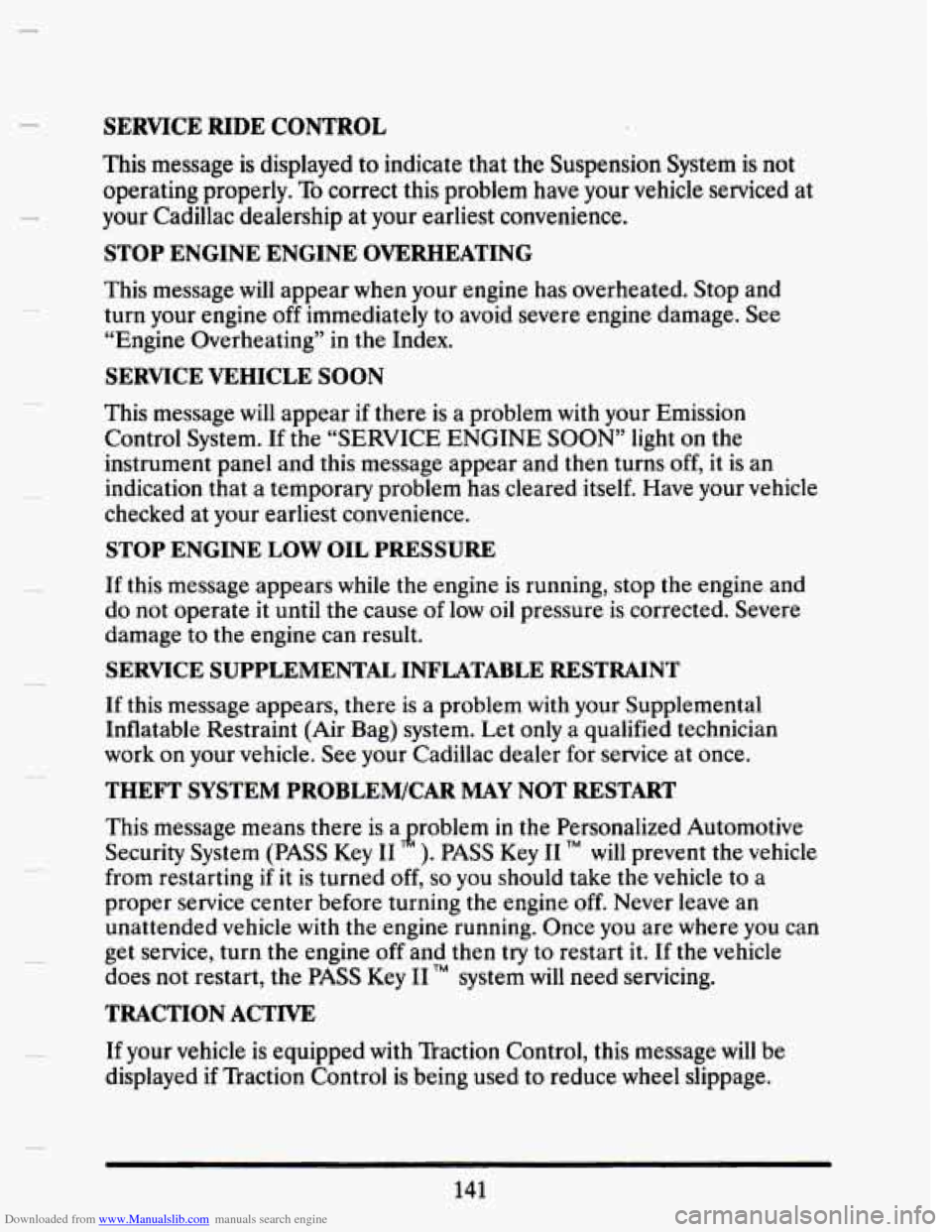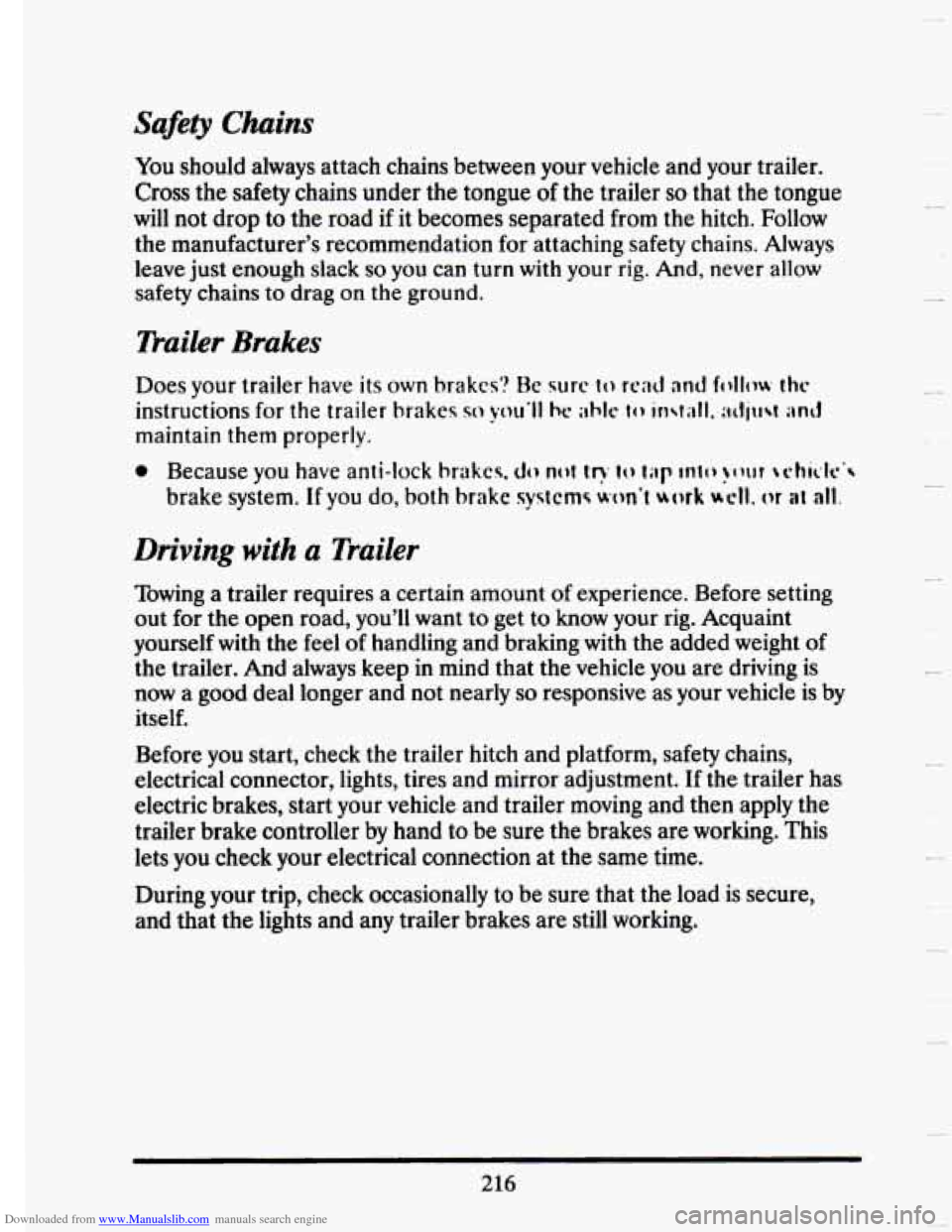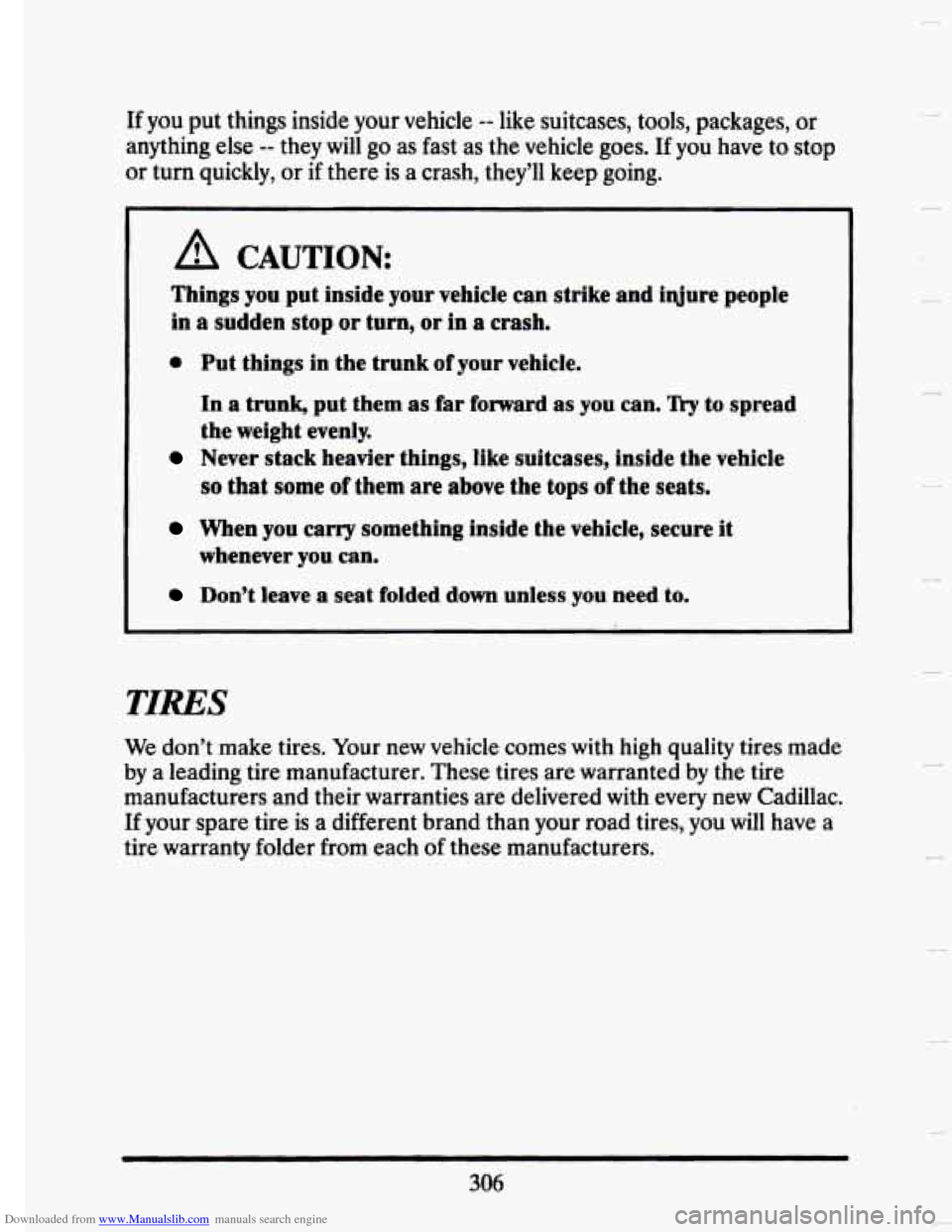Page 155 of 407

Downloaded from www.Manualslib.com manuals search engine SERVICE RIDE CONTROL
This message is displayed to indicate that the Suspension System is not
operating properly.
To correct this problem have your vehicle serviced at
your Cadillac dealership at your earliest convenience.
STOP ENGINE ENGINE OVERHEATING
This message will appear when your engine has overheated. Stop and
turn your engine
off immediately to avoid severe engine damage. See
“Engine Overheating”
in the Index.
SERVICE VEHICLE SOON
This message will appear if there is a problem with your Emission
Control System.
If the “SERVICE ENGINE SOON” light on the
instrument panel and this message appear and then turns off, it is an
indication that a temporary problem has cleared itself. Have your vehicle
checked at your earliest convenience.
STOP ENGINE LOW OIL PRESSURE
If this message appears while the engine is running, stop the engine and
do not operate it until the cause
of low oil pressure is corrected. Severe
damage to the engine can result.
SERVICE SUPPLEMENTAL INFLATABLE RESTRAINT
If this message appears, there is a problem with your Supplemental
Inflatable Restraint (Air Bag) system. Let only a qualified technician
work on your vehicle.
See your Cadillac dealer for service at once.
THEFT SYSTEM PROBLEWCAR MAY NOT RESTART
This message means there is atroblem in the Personalized Automotive
Security System (PASS
Key I1 ). PASS Key I1 TM will prevent the vehicle
from restarting
if it is turned off, so you should take the vehicle to a
proper service center before turning the engine off. Never leave
an
unattended vehicle with the engine running. Once you are where you can
get service, turn
the engine off and then try to restart it. If the vehicle
does not restart, the PASS
Key I1 TM system will need servicing.
TRACTION ACTIVE
If your vehicle is equipped with Traction Control, this message will be
displayed
if Traction Control is being used to reduce wheel slippage.
141
Page 223 of 407
Downloaded from www.Manualslib.com manuals search engine c
Include an ice scraper, a small brush or broom, a supply of windshield
washer fluid, a rag, some winter outer clothing, a small shovel,
a
flashlight, a red cloth, and a couple of reflective warning triangles. And, if
you will be driving under severe conditions, include a small bag of sand, a
piece of old carpet or a couple
of burlap bags to help provide traction. Be
sure you properly secure these items in your vehicle.
Driving on Snow or Ice
Most of the time, those places where your tires meet the road probably\
have
good traction.
However,
if there is snow or ice between your tires and the road, you can
have
a very slippery situation. You’ll have a lot less traction or “grip” and
will need to be very careful.
209
Page 230 of 407

Downloaded from www.Manualslib.com manuals search engine Safety Chains
You should always attach chains between your vehicle and your trailer.
Cross the safety chains under the tongue
of the trailer so that the tongue
will not drop to the road if it becomes separated from the hitch. Follow
the manufacturer's recommendation for attaching safety chains. Always
leave just enough slack
so you can turn with your rig. And, never allow
safety chains to drag
on the ground.
Trailer Brakes
Does your trailer have its own brakcs'? He sure IO read and follow thc
instructions for the trailer brakes so you'll he ilblc to ir~ i~lI, ;rcliw an3
maintain them properly.
Driving with a Trailer
Towing a trailer requires a certain amount of experience. Before setting
out for the open road, you'll want to get to
know your rig. Acquaint
yourself with the feel of handling and braking with the added weight of
the trailer. And always keep
in mind that the vehicle you are driving is
now a good deal longer and not nearly so responsive as your vehicle is by
itself.
Before you start, check the trailer hitch and platform, safety chains,
electrical connector, lights, tires and mirror adjustment. If the trailer has
electric brakes, start your vehicle and trailer moving and then apply the
trailer brake controller by hand
to be sure the brakes are working. This
lets
you check your electrical connection at the same time.
During your trip, check occasionally to be sure that the load is secure,
and that the lights and any trailer brakes are still working.
216
L -4
c
L-
L-
C
Page 245 of 407
Downloaded from www.Manualslib.com manuals search engine A CAUTION:
To help avoid injury to you or others:
Never let passengers ride in a vehicle that is being towed.
Never tow faster than safe or posted speeds.
Never tow with damaged parts not fully secured.
Never get under your vehicle after it has been lifted by the
tow truck.
Always use separate safety chains on each side when towing a
vehicle.
Never use '3" hooks. Use T-hooks instead.
When your vehicle is being towed, have the ignition key off. The steering
wheel should be clamped
in a straight-ahead position, with a clamping
device designed
for towing service. Do not use the vehicle's steering
column lock for this. The transaxle should be
in Neutral and the parking
brake released.
23 1
Page 246 of 407
Downloaded from www.Manualslib.com manuals search engine Don’t have your vehicle towed on the front wheels, unless you must. If
the vehicle must be towed on the front wheels, don’t go more than 55
mph (88 km/h) or farther than 500 miles (804 km) or your transaxle will
be damaged. If these limits must be exceeded, then the front wheels have
to be supported on a dolly.
A CAUTION:
A vehicle can fall from a car carrier if it isn’t properly secured.
This can cause
a collision, serious personal iqjury and vehicle
damage. The vehicle should be tightly secured with chains
or
steel cables before it is transported.
Don’t use substitutes (ropes, leather straps, canvas webbing,
etc.) that
can be cut by sharp edges underneath the towed
vehicle.
232
-:
L.
I
-
Page 265 of 407
Downloaded from www.Manualslib.com manuals search engine C
-
The following steps will tell you how to use the jack and change a tire.
The equipment you’ll
need
is in the trunk
under
the spare tire
cover.
Rotate the plastic
wing nut and remove
that cover to access
the spare tire.
Then remove the wing
nut that secures the
jack and wrench and
remove them from the
trunk.
25 1
Page 310 of 407
Downloaded from www.Manualslib.com manuals search engine DOMESTIC - Turn the headlight housing socket counterclockwise to
unlock socket from lamphousing.
EXPORT - Remove the rubber plug cover and remove plug.
DOMESTIC - Remove headlight housing socket.
EXPORT - Remove both retaining lock clips securing bulb assembly in
headlamp housing.
296
3
Page 320 of 407

Downloaded from www.Manualslib.com manuals search engine If you put things inside your vehicle -- like suitcases, tools, packages, or
anything else
-- they will go as fast as the vehicle goes. If you have to stop
or turn quickly, or
if there is a crash, they’ll keep going.
A CAUTION:
Things you put inside your vehicle can strike and injure people
in
a sudden stop or turn, or in a crash.
0 Put things in the trunk of your vehicle,
In
a trunk, put them as far forward as you can. “ky to spread
the weight evenly.
so that some of them are above the tops of the seats.
Never stack heavier things, like suitcases, inside the vehicle
When you carry something inside the vehicle, secure it
whenever you can.
Don’t leave a seat folded down unless you need to.
TIRES
We don’t make tires. Your new vehicle comes with high quality tires made
by a leading tire manufacturer. These tires are warranted by the tire
manufacturers and their warranties are delivered with every new Cadillac.
If your spare tire is a different brand than your road tires, you will have a
tire warranty folder from each
of these manufacturers.
c1
c